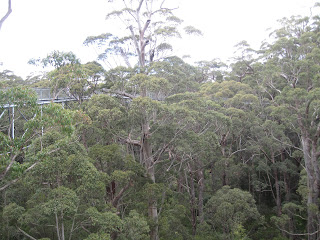A short distance inland from Port Denison, and just north of Eneabba, is the aptly named Western Flora Caravan and Tourist Park. Kept in a totally natural state, the park has a spectacular and constantly changing range of wildflowers for six months of the year. When one lot of flowers finishes, another lot blooms, from about July to December. Apparently this year was particularly good for flowers due to the relatively dry conditions. Park owner and amateur botanist, Allan Tinker, takes guests on a walk - not really a walk, more a slow amble - at 4:30 each afternoon, during which he discusses the ecology of the area by pointing out the interrelationships between plants, insects and animals. After a session with Allan, you see the world in a new and different light, which, after all, is what all good teachers do. We loved our time at Western Flora. It was really beautiful.
 |
| An early morning visit by Euros |
Interestingly, a few kilometres north or south may have the same sort of plants, but slightly different varieties, so we spent some time exloring the local area.
Lesuer National Park, about 50 kms south-west of Eneabba is supposed to have the greatest concentration of plant species in WA. When we visited, WA's floral emblem, the red kangaroo paw, was in bloom and, again, there were flowers and shrubs that we hadn't seen before.
The sleepy little seaside village of Cervantes is situated on the coast a couple of hours north of Perth and in close proximity to Nambung National Park, home of the Pinnacles. Though we'd seen photos of the Pinnacles, we didn't realise that there were hundreds, if not thousands, of them covering quite an extensive area.
While most of the land in this fertile area that they call the wheat belt has been cleared, there are frequent pockets of natural bush in small conservation areas and, of course, the wild plants thrive along the road sides.
On our way to Perth, we call in to New Norcia to have a look at the old buildings of this monastery town.
PERTH
We liked Perth; it's a nice city. Though the CBD is much the same as any other city in Australia, the Swan River estuary is beautiful. Then there are those miles of beaches stretching north of Perth. I did have the idea that the weather would be warmer than it was, though we did have a few hot days.
We managed to visit King's Park on a hot Sunday when the Wildflowers Festival was on, so the park was pretty crowded. At some place there must have been a plant sale as lots of people leaving the gardens were carrying pots of indigenous plants. Most of King's Park is natural bushland with only a small part being landscaped botanical garden. In parts of the park, the views over the Swan River and Perth are spectacular.
Some time in Perth was devoted to catching up on chores and we managed, after some difficulty, to get a replacement part for the van's roof hatch. We thought the
Picasso to Warhol exhibition was very good and very enjoyable, though Warhol's famous Campbell's soup cans didn't do much for me.
.jpg) |
| Perth's Art precinct |
One day was devoted to exploring Fremantle, its old buildings and Maritime Museum.
.jpg) |
Fremantle's famous son
|
Another great day was spent on a visit to Rottnest Island. We were lucky to have a volunteer guide explain the history of the island and buildings and organise a round-the-island bus tour for us.
.jpg) |
| Perth from Rottnest Island |
.jpg) |
| Rottnest Island quokka |
After Perth we spent a couple of days at the very touristy and up market town of Mandurah, south of Perth, after which we made our way down to Busselton, taking a detour en route through the remnants of the tall treed Tuart Forest. This corner of WA is very lush and green, at least at the present time, but I couldn't get over the proliferation of Arum Lilies that were growing everywhere. All along the way there was a real infestation of what I assume is this weed.
Busselton seems to be a very popular holiday destination with multiple accommodation options and houses lining the shores of Geographe Bay, named in 1801 by French explorer Baudin.
There's a lighthouse at the point in Cape Naturaliste National Park. On a walk around the headland, we saw a number of whales making their way south, but I haven't managed to capture any on camera as yet.
Other highlights of the area included Ngilgi Cave - one of the best caves we've ever seen, though I didn't care much for the coloured lighting -
and some stunning rock formations called Canal Rocks:
Currently we're camped at Margaret River. The countryside is very green and it's been pouring rain for the last 24 hours. The drive down from Busselton was through some very tall timber. The area abounds with wineries, cheese and chocolate makers, but we're looking forwared to visiting Augusta and the southern Cape Leeuwin when the weather clears.















































.jpg)
.jpg)
.jpg)
.jpg)
.jpg)
.jpg)
.jpg)


.jpg)